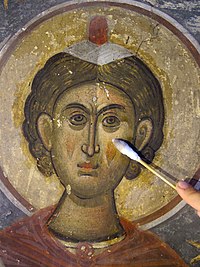
Photo from wikipedia
This special issue deals with the chemical techniques and tools for application in the field of cultural heritage. In particular the articles here presented deals with the topics of interest… Click to show full abstract
This special issue deals with the chemical techniques and tools for application in the field of cultural heritage. In particular the articles here presented deals with the topics of interest for the international conference on metrology for archeology “MetroArcheo2020”. In the field of research related to the characterization, conservation, and restoration of cultural heritage, as well as the techniques of manufacture of objects, it is essential to use diagnostic methods that often are named as archeometric techniques. Archeometry (which measures what is ancient) deals with the scientific study with laboratory analyses of the materials employed. The characterization of the material is essential both to acquire information on the fabrication technique (allowing to advance even hypothesis on the identity of the artist, if there were doubts about the attribution of the work) and to allow the preservation over time. The lack of a thorough knowledge of these aspects can lead to improper choices of methods or materials during the restoration. In fact, the diagnostic approach applied to cultural heritage allows assessing the state of conservation of a work allowing the experts to adopt the best techniques available for the conservation, also monitoring over time the effectiveness of the materials and the treatments used. In this area, collaboration between experts from various disciplines is essential. It will therefore be necessary for the chemist to work with the physicist, geologist, archeologist, conservator, etc. Moreover, the diagnostics applied to cultural heritage is a very complex discipline from the technical point of view because we are always faced with different problems and because artistic techniques are hardly “standardized.” The range of materials used in the past is wide and consequently also the conditions of conservation and the products of degradation that have been generated over time can be very variable. The analytical techniques that can be used in archeological studies are different depending on what you want to investigate and the information you want to obtain. First of all, it is important to follow an operational protocol, consisting of several points. The first point is the choice of the sample that must be representative of what you want to investigate. In the case in which a sampling must be carried out, micro-samples will be taken in particular areas (for example, in the case of a vase for which we want to investigate the chemical composition of the ceramic body or of the coating, the sampling will be carried out in an already damaged zone that may present some chipping; in the case of a painting, the sampling is even more problematic and delicate and must be carried out under the supervision of the art historian). It is also possible to obtain important information about the works using some properties of light: the investigations in grazing light, or in ultraviolet and infrared light, can in fact show details otherwise not visible such as repainting or afterthoughts of the artist. Depending on the information to be obtained and the type of analysis to be performed, the method of sampling may be different (solid, powder, or liquid). The analytical techniques applicable to the study of cultural heritage are different and allow to obtain both information on the chemical composition of the artifact and useful information to plan a proper restoration. The analysis can be aimed at the study of morphology, molecular composition, chemical composition at the elementary level, crystalline or amorphous structure. Obviously, all these methodologies will provide complementary results that will be combined within a sort of puzzle. In the * Paola Fermo [email protected]
Journal Title: Environmental Science and Pollution Research
Year Published: 2022
Link to full text (if available)
Share on Social Media: Sign Up to like & get
recommendations!